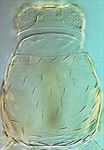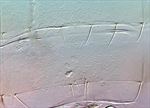Generic diagnosis
Female macropterous. Head much smaller than pronotum; mouth-cone elongate and beak-like; maxillary palps 3-segmented; eyes large, without pigmented facets; ocellar setae I present, setae III small; three pairs of short postocular setae. Antennae 8-segmented, segment I without paired dorso-apical setae, segments III and IV with sense-cones forked, III–VI with some microtrichial rows on both surfaces. Pronotum slightly longer than wide; six to seven pairs of posteromarginal setae, no long setae but posteroangulars often slightly more obvious. Mesonotum with median pair of setae far from posterior margin; campaniform sensilla present. Metanotum with longitudinal striae; median pair of setae far from or at anterior margin; campaniform sensilla present. Fore wing narrow, first vein with long gap in setal row, six to eight basal and three distal setae; second vein with four widely-spaced setae; clavus with 5 veinal and 1 discal setae, posteromarginal fringe cilia wavy. Prosternal ferna weakly connected medially; basantra membranous, without setae; prospinasternum broad and transverse. Mesosternum with sternopleural sutures reaching anterior margin; endofurca without spinula. Metasternal endofurca without spinula. Tarsi 2-segmented; fore femora more or less enlarged; fore tibiae often with inner apical tooth. Tergites with transverse striae, without ctenidia, not clearly divided from lateroterites; II–VIII with craspeda continuous; IX with two pairs campaniform sensilla, X with median split almost complete. Sternites without discal setae; II–VII with craspeda lobed; III–VII with three pairs of posteromarginal setae, II with two pairs; VII without craspeda medially, S1 setae in front of posterior margin, S1 and S2 close together medially.
Male similar to female; tergal craspeda often with teeth; tergite IX often without stout S1 setae; sternites without pore plates.
Biological data
Little is known about the biology of most species, but they seem to be associated mainly with young leaves, on a wide range of unrelated plants, rather than with flowers, and apparently not with grasses.
Distribution data
This is a genus of the Old World tropics, with two species from Africa but with the other species described from various countries between India, China and northern Australia.
Nomenclatural data
Rhamphothrips Karny, 1913: 123. Replacement name for Rhynchothrips Karny, 1912, not Rhynchothrips Hood, 1912; type species Rhynchothrips tenuirostris Karny 1912, by monotypy.
This genus comprises 20 species (ThripsWiki, 2020), of which five are recorded from China:
aureus Ananthakrishnan, 1954: 159.
dalbergiae Li, Li & Zhang, 2018: 398.
parviceps (Hood, 1919: 92). (Perissothrips)
quintus Wang, 1993: 341.
santokhi Kulshrestha & Vijay Veer, 1984: 36
Relationship data
Thripidae sub-family Thripinae: this is a diverse group involving more than 230 genera. The chaetotaxy of sternite VII of females, with the two median pairs of setae on sternite VII very close together medially, is shared with species in the closely related genera Exothrips and Parexothrips, and also with species of Tusothrips. In contrast to these, the species of Rhamphothrips have a remarkably small head but very long mouth cone (Mound & Tree, 2011). Li et al. (2018) provided an identification key to the five species they recognised from China.
References
Li YJ, Li ZY & Zhang HR (2018) A new species and two new records of Rhamphothrips (Thysanoptera: Thripidae) from Southwestern China. Zootaxa 4446 (3): 397–400.
Mirab-balou M, Yang SL, Gao JQ & Tong XL (2014) A newly recorded genus of the Rhamphothrips genus-group (Thysanoptera: Thripidae) from China. Zoological Systematics 39 (4): 583–587.
Mound LA & Tree DJ (2011) New records and four new species of Australian Thripidae (Thysanoptera) emphasise faunal relationships between northern Australia and Asia. Zootaxa 2764: 35–48.
ThripsWiki (2020). ThripsWiki - providing information on the World's thrips. <http://thrips.info/wiki/Main_Page>


